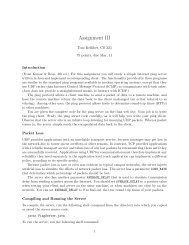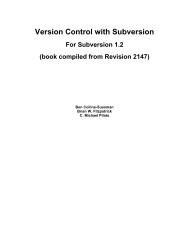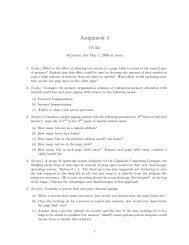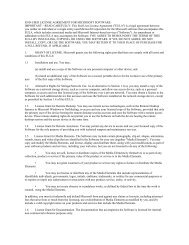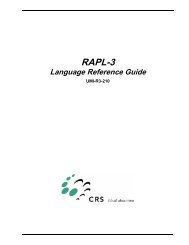Flesh and Machines - Phoenix Goucher
Flesh and Machines - Phoenix Goucher
Flesh and Machines - Phoenix Goucher
You also want an ePaper? Increase the reach of your titles
YUMPU automatically turns print PDFs into web optimized ePapers that Google loves.
Throughout the twentieth century there were many more blows to mankind's specialness, though none as severe as<br />
the loss of the Earth-centric universe or the loss of the direct creation of mankind by God. Perhaps in reality some of<br />
these blows should be seen as severe, but the vast majority of people have still not taken them seriously nor thought<br />
through their consequences.<br />
To a society that was getting used to the idea that science unveiled secrets of the universe <strong>and</strong> led to an orderly<br />
explanation of all that happened, physics provided three unwelcome blows. These were the theory<br />
of relativity, quantum mechanics, <strong>and</strong> the Heisenberg uncertainty principle. Each of these in its own way weakened<br />
the idea that it was possible for a human to ultimately know what was going on in the universe. People's senses were<br />
not the ultimate arbiter of what was what in the universe. There were things that were ultimately not able to be<br />
sensed. These three realizations of physics ate away even more at the idea of the specialness of man—man could not<br />
know ultimate truths because they were unknowable.<br />
When Crick <strong>and</strong> Watson discovered the structure of DNA, there was a further weakening of specialness. Soon it was<br />
found that all living creatures on Earth shared the same sort of DNA molecules <strong>and</strong> used the same coding scheme to<br />
transcribe sequences of base pairs into amino-acid building blocks of proteins. The proteins so produced were the<br />
mechanism of the cell that determined whether it was a bacterium, the skin of a lizard, or a human neuron in<br />
prefrontal cortex. But it was all the same language. Even worse, we humans shared regulatory genes, relatively<br />
unchanged, with animals as simple as flies. There were even clear relationships between some genes in humans <strong>and</strong><br />
in yeast. In early 2001 the two human genome projects announced that there were probably only about 35,000 genes<br />
in a human—disappointingly few—less than twice as many as in a fruit fly. These discoveries hammer home the<br />
nonspecialness of humans. We are made of the same material as all other living things on this planet. Furthermore,<br />
our evolutionary history <strong>and</strong> relationship to all other living things is clear to see. We share some 98 percent of our<br />
genome with chimpanzees. We really are just like those animals, separated by a sliver of time in evolutionary<br />
history.<br />
<strong>Machines</strong><br />
The two major blows to our specialness, that Earth is not the center of the universe <strong>and</strong> that we evolved as animals,<br />
did not come suddenly upon us. In each case, there were precursors to Galileo <strong>and</strong> Darwin, debates <strong>and</strong> vituperative<br />
arguments. These lasted for decades or centuries before the crystallizing events <strong>and</strong> for decades or centuries<br />
afterward. Indeed, it is only with the hindsight of history that we can point to Galileo's trial <strong>and</strong> Darwin's publication<br />
as the crystallizing events. They may not have seemed so out of the continuum to the participants or observers.<br />
We have been in the beginning skirmishes of the third major challenge to our specialness for a period of almost fifty<br />
years now. We humans are being challenged by machines. Are we more than machine, or can all of our mental<br />
abilities, perceptions, intuition, emotions, <strong>and</strong> even spirituality be emulated, equaled, or even surpassed, by<br />
machines?<br />
The machines we had been building for the last few millennia had never really challenged our specialness until<br />
recently. They were sometimes stronger or faster than us, or could fly while we could only walk<br />
<strong>and</strong> run, but animals could do all those things too.<br />
With the invention of the computer <strong>and</strong> some clever programming of them in the 1950s <strong>and</strong> '60s, machines started to<br />
challenge us on our home turf: syntax <strong>and</strong> technology. As artificial intelligence proceeded. machines regularly<br />
started operating in arenas that had previously been the domain of unique human capabilities.<br />
Early programs enabled computers to prove theorems in mathematics—not very hard ones at first, but proofs from<br />
the first few pages of the book Prindpia Mathematica by Bertr<strong>and</strong> Russell <strong>and</strong> Alfred<br />
North Whitehead, an exceedingly erudite attempt at formalizing mathematics. Computers were doing something<br />
with an intellectual flavor that only the most educated people could underst<strong>and</strong>. There was also early progress on<br />
computers processing human languages, although there was a long hiccup from the mid-sixties to the mid-nineties<br />
without much outwardly visible progress. But those early programs, along with Noam Chomsky's generative<br />
grammars for all human languages, showed that perhaps language <strong>and</strong> syntax could be explained through fairly<br />
simple sets of rules, implementable on computers. By 1963 there was a computer program that could do as well as<br />
MIT undergraduates on the MIT calculus exam. By the mid-sixties, computers were playing chess well<br />
enough to compete in amateur chess tournaments.



